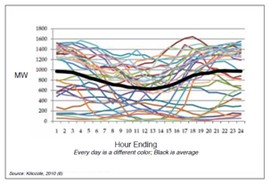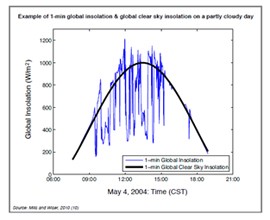Transactive Control and its Role in Optimizing Grid Performance
The Pacific Northwest Smart Grid Demonstration Project (PNW-SGDP) is implementing a leading-edge technology it calls “transactive control” that is considered a specific instantiation of a GridWise Architecture Council Transactive Energy architecture. The intent of transactive control is to standardize a scalable, distributed mechanism for exchanging information about generation, loads, constraints and responsive assets over dynamic, real-time forecasting periods using economic incentive signaling.
This mechanism offers the promise of optimizing grid performance (cost, reliability, scalability) in the face of the rapid expansion and adoption of highly variable (and distributed) generation and storage resources, highly variable and grid-responsive loads, new utility pricing models, and the proliferation of smart energy devices.
This transactive control technology and architecture promises to move the grid’s control architecture from the traditional control model (whereby assets in the system are managed/monitored by central operations centers) to a distributed control architecture similar in spirit to the routing architectures of the Internet, industrial control or other highly complex, distributed decision architectures.
Today’s Grid Architecture
Today’s electric grid control architecture is a hierarchical model intended to manage a small number of generation resources, moving through a constrained number of transmission and distribution points, to a number of sites (buildings/homes), and ultimately to consumer/user devices and end loads, as shown below. Typically, energy flows in one direction, from generation to loads.
Figure 1: Today’s Grid Architecture.
Image Courtesy Electric Power Research Institute (EPRI).
The actual control information and control points are limited to the generation, transmission and distribution components of the system. This design provides redundancy, reliability and the ability to transmit electricity over vast geographic distances, within the limits of today’s grid. However, the control architecture of this network as a whole has grown organically, is not standardized, and does not scale with the adoption of the new policies, intermittent generation technologies, intelligent grid-aware loads and regulations that are just starting to be implemented.
Today’s grid operating system has evolved since Thomas Edison operated the first power system at Pearl Street in New York City in 1882, but its fundamental architecture and philosophy are substantially unchanged.
The Current Control Architecture is a “Dead End”
The following industry developments and trends are already straining the control mechanisms of the current grid architecture:
| 37 states representing over 80 percent of the US population have enacted renewable portfolio standards or goals that require 10% to 33 percent of energy delivered to customers by 2020 to be obtained from renewable resources. Many of these resources (wind, solar, etc.) produce a highly variable, unpredictable energy supply. For example, the diagrams on the right illustrate the highly variable nature of wind power and solar power generation. Rooftop solar, distributed storage (including electric vehicle batteries), and other technologies provide the potential to feed energy back into the grid, creating a large adoption of two-way energy flows. |  Figure 2: Wind power daily variability  Figure 3: Solar power hourly variability |
| New demand response technologies coupled with new pricing models and smart end-devices offer the promise to enable peak-shaving and enhanced ancillary service strategies for consumers and utilities to avoid high peak costs and to avoid large cap-ex expenses for peak generation capabilities while optimizing for a growing number of participants in the system. |
It’s predicted that the adoption of these technologies may require the number of managed grid resources to grow by a factor of 1,000 – into a range measured in the tens of millions – which is a number that approaches Internet-scale resources, and demands a scalable control infrastructure. The ultimate network architecture is illustrated in Figure 4, with two-way electricity flow, distributed and variable, renewable generation resources, and a large proliferation of smart devices. The control of this complex system cannot be accomplished with today’s grid management architecture.
Figure 4: A Transactive Grid Architecture.
Image Courtesy Electric Power Research Institute (EPRI).
In the next post, we’ll look at the “distributed” part of transactive control, see it in action in the Pacific Northwest Smart Grid Demonstration Project, and discuss its benefits.